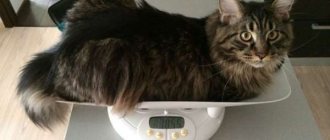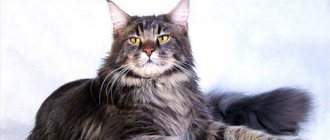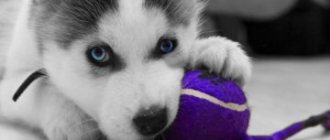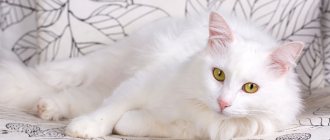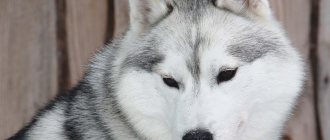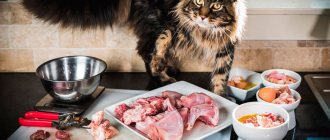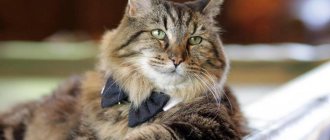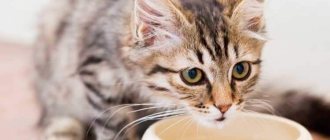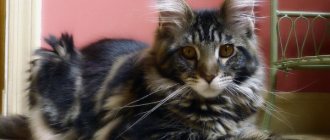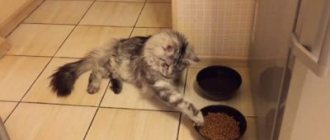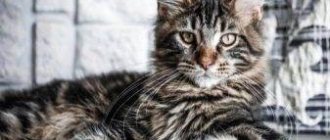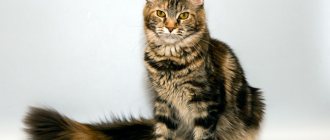Future owners and just people who have seen a Maine Coon for the first time are interested in what height and weight this cat reaches. The elongated body, large head, paws and tail, developed muscles and long hair give the impression that this is a very massive animal.
There are stories that say Maine coon cats gain up to 15-20 kg. And many owners try to fatten their pet to such parameters. You should approach this with caution. It is useful to know what sizes are normal for Maine Coons, so as not to harm your pet.
History of the origin of the Maine Coon cat breed
The origin of the Maine is the most natural: it is an aboriginal cat, which, over the course of many, many years of the population’s existence, in the process of natural selection and adaptation to the surrounding world, acquired certain features. The handsome Maine Coons are Americans, and more specifically, they originally lived in North America, within the state of Maine. Since the climate of those lands was always humid in the summer months, and winter brought with it frosts and constant snowfalls, the fur coat of cats of this breed was very thick and dense, and the body became hardy.
Features of the breed's exterior
The exterior of the Maine Coon is unique; there are no exact analogues of such a cat anywhere in the world (see the largest Maine Coon in the world).
Description of the Maine Coon breed:
- The body is elongated and large. The neck and chest are wide.
- The tail is approximately equal to the length of the body.
- The head is large, high-set ears with tufts at the tips, a sharp convex chin, narrow, relatively small “live” eyes (compared to the large head).
- The eyes are located close to each other on a wide muzzle. Some lovers of the breed jokingly call the face of these cats a “felt boot face,” since the nose and jaw are noticeably pushed forward from the base of the head.
- The eye color is predominantly golden. Sometimes greenish, amber, light orange, or yellowish colors are found, extremely rarely - blue or light blue.
- The coat is thick, long, growing along the body.
- The areas of the body with the longest hair are the back, belly, and sides of the hind legs. Short hair grows mainly on the head, neck, and shoulders.
Why does a Maine Coon kitten not gain weight?
As soon as the owner notices a discrepancy with the body weight table, it is worth seeking help from veterinarians. Insufficient recruitment can be caused by a number of reasons:
- lack of vitamins;
- non-compliance with energy balance;
- the kitten is stressed;
- genetic or acquired diseases of the kitten.
If a cat gives birth to small newborn kittens, they may develop more slowly and take longer to reach the required weight and body size. Larger ones develop much faster than their smaller peers. Small size is often due to genetics.
Read also: Terminal stage of the disease
Sometimes there are situations when just small kittens are born. This can be called a genetic failure; it cannot be corrected. You should not give your kitten any supplements that affect growth on your own. All drugs should be prescribed only by a veterinarian and if there are compelling reasons for their use.
Genetic factors
If the kitten's parents are large, then it also has a very high chance of reaching the maximum size of the breed. Genetics is the most important factor determining the weight, length, and height of an animal. Although this does not necessarily mean that the cat will weigh exactly as much as its parents. There is always a possibility that a grandparent will be able to pass on their genes to their descendants.
We recommend reading: American Raccoon Cat: comparisons, features, facts
How old do Maine Coons grow?
Maine Coons grow up to 5 years old. In some individuals, this process is completed earlier - it all depends on the conditions of detention, nutrition and genetic data of the cat. For example, the table indicates that at 3 months a Maine Coon should weigh 2-2.4 kg, but the scales show the owner other, lower numbers. If the baby is healthy, then there is no need to worry - over time, the Maine Coon will gain the missing kilograms.
In Maine Coon cats, monthly weight gain may also differ from the data indicated in the table. Most often this happens closer to the year, when females enter the puberty phase. At this time, all efforts are devoted to the formation of internal organs, and growth slows down. Later, after the first mating, the cat can quickly recover and even grow.
Important! An indirect indicator of how big a Maine Coon will grow is its parents. Large offspring are always born from equally tall and heavy male cats.
Size standards and maximum weight
These animals are rightfully considered the largest domestic cats among those breeds that are able to live with humans without any problems. All four-legged champions and record holders for weight and height are Maine Coons. They have significantly outgrown the rest of their competitors. The average weight of representatives of this breed is 8-10 kg for males and 4-7 kg for females.
Like other native species, big Manx cats mature late. They enter a sexually mature state quite quickly - females can give birth to offspring already at the age of 7-9 months, but Maine Coons grow up to 4-5 years.
At the age of 5 years, the weight of a Maine Coon cat remains almost unchanged. As soon as a pet loses its appetite, loses weight and becomes lethargic (even in the absence of other signs of illness), it needs to be shown to a veterinarian in order to exclude the development of diseases, which often pass in a latent chronic form, but necessarily manifest themselves in later stages.
This is interesting! A cat named Omar became a contender for entry into the Guinness Book of Records. By the end of the first year of his life, he had already gained 10 kg, and later each year he added one more. Now the title candidate is 4 years old, the actual body length of this Maine Coon is 1.2 meters and, standing on his hind legs, he can easily take food from the dinner table.
Maine Coon kitten sizes
Maine Coon kittens are born larger than representatives of other breeds, the average weight of babies is 120-170 g. For comparison, Siberian kittens are born weighing from 60 to 130 g. In general, the size of Maine Coon kittens depends on many factors:
- the number of newborns in the litter - the more kittens, the less their weight;
- gender of the baby - boys develop faster and reach larger sizes;
- genetic characteristics, etc.
Maine Coon kittens are born larger than representatives of other breeds / Yandex Collections
The rate of growth and development of kittens is determined by environmental conditions, as well as the health of the mother cat. To give birth to healthy and strong babies, a pregnant cat requires balanced nutrition, calm, warmth, peace and quiet.
The development of Maine Coon kittens occurs unevenly, but faster than in babies of other breeds. The average daily weight gain of Maine Coons is 10-11 g, and in the first month of life their size increases almost five times.
Nutrition
When purchasing a small Maine Coon, it is better to feed him his usual food for a while. Then you can introduce the kitten to other foods.
A complete diet for a small Maine Coon should contain up to 40% protein, 15-30% fat, 2.5% fiber, and the rest should be carbohydrates.
When feeding kittens, it is important to follow a diet. The main diet is raw lean meat. These are beef, chicken, rabbit, and offal. To strengthen joints, you need chicken scallops, beef tendons, and pig ears. Meat should be frozen for at least three days.
The source of minerals will be raw chicken necks, heads, backs, paws, and tails. They must be ground or given whole. Raw yolk is very useful for kittens.
Be sure to read:
What to feed a Maine Coon correctly: an adult cat, a kitten or a female cat
When purchasing a small Maine Coon, it is better to feed him his usual food for a while
Fish should be given with caution and infrequently. Kittens drink milk for up to two months, and then their body loses the ability to digest lactose. It is replaced with fermented milk products, cottage cheese, and hard cheese.
Sometimes kittens happily eat raw grated vegetables and fruits and herbs. Adding a small amount of olive oil will help. There must be clean water available at all times.
It is not recommended to feed kittens food from the human table: it contains too many different additives that are harmful to the animal’s digestion.
Natural nutrition table for Maine Coon kittens by month
The nutritional norms and diet for Maine Coon kittens are presented in the table:
| Age in months | Daily value in grams | Number of feedings per day | Diet |
| Up to a month | Around the clock | Mother cat's milk | |
| 1,5-2 | 150-190 | 6 | Milk, liquid porridge, pureed meat |
| 2-3 | 180-240 | 4 | Raw lean meat, liver, some sea fish, vegetables, fruits, egg yolk, kefir, yogurt, a little olive oil. |
| 3-6 | 180-220 | 4 | Offal, chicken feet, heads, backs are added |
| 6-9 | 200-250 | 3 | Same diet |
| 10-12 | 180-220 | 2 | Same diet |
Feeding kittens with prepared food
High-quality industrial cat food contains all the necessary nutrients. Some manufacturers produce special food for Maine Coons: Bosch Sanabel Kitten, Royal Canin, Hills.
The amount of dry food is calculated individually and depends on the size of the kitten. First, the granules should be diluted with store-bought milk. Adults can be given canned food.
Industrial feeds are stored for a long time and are convenient to use. The packages usually indicate the serving size and other recommendations.
Maine Coon growth chart by month by age
| Age | Cat (weight in grams) | Cat (weight in grams) |
| After birth | 170 | 120 |
| One week | 230 | 190 |
| Two weeks | 380 | 340 |
| One month | 700 | 600 |
| Two month | 1350 | 1250 |
| Three months | 2200 | 1850 |
| Four months | 3400 | 3000 |
| Five months | 4500 | 3500 |
| Six months | 5000 | 3800 |
| Seven months | 5500 | 4300 |
| Eight months | 6000 | 4800 |
| Nine month | 6300 | 5000 |
| Ten months | 6900 | 5300 |
| Eleven months | 7400 | 5700 |
| Twelve months | 8000 | 6000 |
| Two years | 10000 | 6800 |
| Two and a half years | 12500 | 7300 |
| Three years | 14000 | 8000 |
Maine Coon weight by month
Newborn Maine Coon kittens weigh from 120 to 180 grams, although very small (80 g) animals are often viable. Experts distinguish 2 initial stages of kitten growth:
- Neonatal cycle – first 4 days. At this time, development is highly dependent on the complexity of labor and birth order.
- Sucking month. The only food for the baby is mother's milk and in any case adds at least 10 g to the baby's weight every day. But the normal value is 5-8 times more (50-80 g/day).
Girls weight
The average weight of a newborn cat is 100-150 g.
How to choose a kitten?
To choose the right Maine Coon kitten, you should first study the breed standards according to the European and American versions of the systems, and also visit several exhibitions. After this, you can confidently go to the nurseries that you like.
We recommend reading: Havanese Bichon (Havanese): everything about the dog, photo, description of the breed, character, price
How to distinguish it from an ordinary cat?
It is sometimes difficult for a non-professional to distinguish a purebred animal from a mongrel cat. What to pay attention to in this case, here are the characteristic features of the breed:
- Maine Coons are larger than regular kittens. On average, a newborn weighs 100-150 grams, and regular kittens weigh 80-100 grams.
- The Maine Coon kitten is more active and stronger than ordinary cats.
- By three months, an animal of this breed already weighs on average about 2 kilograms for girls and 2.5 for boys. Simple cats at this age weigh no more than one and a half kilograms.
- The coat is thicker and fluffier than that of ordinary kittens.
- The body is large, the head is massive.
- The tail is thick, the paws are impressive, sometimes even at a young age you can see tufts of hair between the toes - a characteristic feature of Maine Coons.
- A purebred kitten has at least 4 generations of ancestors in its pedigree.
Choosing a small Maine Coon
- If you wish, you have the right to look at the kitten’s parents and ask about their veterinary passports and pedigrees.
- If the cattery has other popular cat breeds, breeders may offer mixed breeds or crossbreeds. Of course, they can be wonderful and cute, but they will no longer be considered real Maine Coons.
- If you are offered a show class kitten with no breeding restrictions, then most likely you are again being offered a cross between two breeds.
- Pay attention to the character of the Maine Coon. He should not be intimidated or aggressive.
- You can buy a kitten only after 3 months, when the mother cat has passed on the necessary animal skills to it.
Colors
Maine Coons have two genetic colors - red (red) and black. The rest are their shades or lightened versions. The documents use a special EMS color coding.
In the photo there is a Maine Coon cat: black color
Maine Coons are divided into several groups based on color: those with a pattern (tabby), without a pattern (solid), tortoiseshell, silver and smoky.
Components of a tabby pattern:
- the letter "M" on the forehead;
- the mirror of the nose and eyes are outlined in dark;
- horizontal stripes on the paws, and small spots on the stomach;
- “necklace” on the chest made of stripes.
Tabby types:
- Classic (marble): stripes are drawn along the spine, there is often a “butterfly” between the shoulder blades, and rounded marks on the sides;
- Spotted: dotted stripes or small spots;
- Brindle: dark stripe on the back, vertical lines along the sides;
- Ticked: an atypical color found in more eastern breeds. The pattern is marked only on the muzzle, the tip of each hair is painted in a dark color.
The color of solids can be: red, red, black, blue, cream, white. Tortoiseshell: torti (cream) or toby (black, brown, red).
In the photo there is a Maine Coon cat: red color
Record holders
According to the Guinness Book of Records, the longest cat is the Maine Coon Stewie, whose full name is Stuart Gilligan. Its length was 123 cm. The record was set in the USA on August 28, 2010. Stewie died in 2013. The current record holder for length is another Maine Coon cat named Ludo, whose length is 118.33 cm.
Appearance Features
It is worth knowing that at a young age it is quite difficult to notice the difference between animals. Thoroughbreds have similarities to ordinary ones, but they still have unique features. When inspecting, pay attention to:
- Ears. They are noticeably larger than those of ordinary pets, set almost at a right angle to the head, there is no forward bend, like in a Siberian cat. They are wide at the base and then gradually narrow. They end with a tassel - a unique external feature. The kitten can be born with it, more often it grows later, but by a maximum of 3 months there should already be a tassel on its ears. For this reason, it is better to select a pet at this age.
- Head. It is slightly elongated, since the length is slightly greater than the width. All features are clear, and the whisker pads form a “box”, making the muzzle square. The cheekbones protrude noticeably, which is not typical for ordinary domestic kittens.
- Eyes. They are slightly slanted and almond-shaped, unlike the rounded ones of other cats.
- Paws. Firstly, they are quite large even in babies, and secondly, tassels also grow on them - between the claws.
- Tail. This part of the body in purebred animals is long, about 2 times longer than in their domestic relatives. It is worth noting that selling Maine Coons is a profitable business, and there is a high risk of fraud. The breeder can tell that the tassels have not yet grown, the shape of the face sometimes seems similar, but the length of the tail can reveal the truth. Therefore, it is better to cooperate with reliable nurseries, where they will provide you with all the necessary documents.
- Wool. Even in kittens it is of medium length and thick.
- Dimensions. At the age of five weeks, Maine Coons are already comparable in size to a six-month-old ordinary kitten; at 4-5 months they “catch up” with an adult.
- Body type. It should be strong, the chest should be wide, the bones should be massive.
Also, purebred representatives of the breed are much more active and mobile than their ordinary counterparts, they develop faster and switch to food earlier.
Linear growth rates
Mostly cat lovers are interested in information about the fatness of Maine cats. Therefore, participants began to be weighed at exhibitions.
However, the data on how long Maine Coons are is no less interesting; it’s not for nothing that they occupy first place in the ranking of the largest domestic cats. Moreover, in many photos, owners try to demonstrate the size of the pet, taking pictures when it is stretched out in length.
The average height and length are as follows (in cm):
- The body is rectangular, elongated. Body length – 95 +/- 5
- The tail is long and very fluffy. Length – 35 +/-2
- Height at withers – 32.5. There is information about a height of 40 centimeters.
- Waist and chest girth – 32.
It also takes a Maine Coon 3-4 years to reach its full length. The largest representative of the breed listed in the Guinness Book is the cat Stewie. The length of his body from the tip of his tail to his nose was 123.2 cm.
What to feed a Maine Coon: kitten, adult cat
How to name a Maine Coon: nicknames for cats and cats
How to distinguish a Maine Coon from an ordinary cat: 5 signs of thoroughbred
Maine Coon Polydact: a little larger than usual
Sterilization and castration of Maine Coons: features
Source
Weight table by age
The development of the animal occurs quite evenly, but a jump in growth processes, as a rule, occurs in the fourth or fifth month of a pet’s life:
| Age | Male weight | Female weight |
| a week | 240-280 g | 240-260 g |
| two weeks | 250-350 g | 300-400 g |
| month | 630-820 g | 560-740 g |
| two month | 1.23-1.50 kg | 1.1-1.4 kg |
| three months | 1.8-2.3 kg | 1.7-2.3 kg |
| four months | 3.0-3.8 kg | 2.7-3.6 kg |
| five months | 3.2-5.5 kg | 2.9-4.3 kg |
| six months | 3.5-5.8 kg | 3.0-4.5 kg |
| seven months | 4.2-6.5 kg | 3.5-4.9 kg |
| eight months | 4.4-6.8 kg | 3.8-5.2 kg |
| nine month | 5.1-7.2 kg | 4.1-5.5 kg |
| ten months | 5.3-7.6 kg | 4.2-5.8 kg |
| eleven months | 5.6-8.1 kg | 4.3-6.1 kg |
| twelve months | 5.7-9.0 kg | 4.5-6.8 kg |
| one and half year | 6.0-9.5 kg | 4.5-7.0 kg |
| two years | 10.0 kg | 4.7-7.3 kg |
| two and a half years | 12.0 kg | 7.5 kg |
| three years | 13.0-16.0 kg | 7.5-8.0 kg |
Return to content
Body weight at different stages of development
From the moment of birth to the peak stage of growth, the development of the Maine Coon is divided into four main stages:
- Stage one: neonatal. It lasts for the first four days. Average daily weight gain is directly related to the condition of the baby after birth.
- Stage two: sucking. The stage continues for the next 4 weeks. Body weight increases steadily and evenly: the average increase is from 20 to 50 g. By the end of the first month of life, kittens of the same litter level out, and prenatally underdeveloped babies are restored to a normal state. The weight of a one-month-old kitten should be from 0.5 to 0.8 kg, and that of a two-month-old kitten should be from 0.9 to 1.5 kg.
- Stage three: transitional. The stage continues until seven weeks of age. It is characterized by a change in the type of feeding. In the fifth week, due to the transition to solid food, a slowdown in weight gain is acceptable. But by the seventh week this transition ends and body weight should rise again. Kittens begin to gain weight, as the new diet includes almost all the required vitamins and nutrients.
- Stage four: post-suction stage. The period lasts from the eighth week until the animal completes its growth. These are the kitten’s first steps towards an existence independent from its parent. Growth stops by the age of three, and the final formation of the body ends at 4–5 years of life.
By regularly measuring the weight of a Maine Coon, you can understand whether the formation of offspring is proceeding normally, and give a forecast of what it will be like. The table below shows weight from the first week of life to the age of three.
| Age | Cat body weight, g | Cat body weight, g |
| 7 days | 240 — 260 | 240 — 290 |
| 14 days | 320 — 410 | 340 — 420 |
| 1 month | 550 — 740 | 640 – 820 |
| 2 months | 1000 — 1400 | 1100 — 1500 |
| 3 months | 1600 — 2200 | 1800 — 2400 |
| 4 months | 2600 — 3500 | 3000 — 3800 |
| 5 months | 2800 — 4300 | 3200 — 5500 |
| Six months | 3200 — 4500 | 3900 — 6000 |
| 7 months | 3400 — 4900 | 4200 — 6500 |
| 8 months | 3700 — 5200 | 4500 — 6900 |
| 9 months | 4000 — 5400 | 5000- 7000 |
| 10 months | 4100 — 5800 | 5200 — 7700 |
| 11 months | 4200 — 6100 | 5700 — 8000 |
| Year | 4500 — 6800 | 5700 — 9000 |
| 1.5 years | 4500 — 7000 | 6000 — 9500 |
| 2 years | 4500 — 7200 | 10000 |
| 2.5 years | 4500 — 7200 | 12000 |
| 3 years | 4500 — 7500 | 13000 – 15000(neutered) |
The ideal average weight of a healthy Maine Coon reaches 10 kg, but there are also slightly larger individuals up to 12 - 13 kg. But this is rather an exception, typical of neutered cats aged three to five years.
Excess weight is also observed in artificially fed kittens, since a large number of biological additives cause disruption of the endocrine system. Maine Coons should not be overfed.
A young kitten that has already gained more than 10 kg will have health problems, since obesity causes severe diseases of the pulmonary, cardiovascular system and other internal organs.
No matter how strong and resilient a kitten is, it is also prone to hip dysplasia and other serious, difficult-to-treat diseases, the possibility of developing which increases with every extra kilogram. Such animals must be constantly under the supervision of a veterinarian.
There is no need to believe in the existence of mythical 20-kilogram cats and chase records, achieving the maximum body weight of your pet in every conceivable and inconceivable way. After all, the handsome Maine Coon is not raised for slaughter. It is necessary to create comfortable conditions for your pet, provide a high level of quality of life, maintain his health, and not strive to raise a giant.
Source
They don't like loneliness
Maine Coons always strive for the room where there is a person; without attention, they suffer greatly. They, as a rule, choose one owner and remain devoted to him for life. If your cat chose you out of all the family members, then you are very lucky, but there are disadvantages: he is unlikely to give you privacy in the toilet or shower. The doors in the room you are in should always be open. These animals generally hate loneliness: even if you leave the house for just a couple of hours, the Maine Coon will greet you with violent screams. But cats of this breed are easy to teach dog tricks. Our pet always comes when called and knows how to fetch. Some owners even boast that they taught their pet the “sit” command. It’s better for you to always be close, otherwise they may be offended by you and will never let you caress them again. Therefore, either take it with you always or don’t start it at all.
What to do if your pet is obese
If your pet is obese, it is first important to determine the cause. Some foods are contraindicated for kittens and adult animals, such as chicken and fish bones, which can damage the esophagus. You should not give your pet raw meat, especially pork. Meat products without heat treatment can become a carrier of infection and worms. Starchy vegetables, such as potatoes, can cause diarrhea, so you shouldn't give them to your pet. Legumes have a negative impact on the digestive tract. Smoked meats, pickles, spicy and fatty foods are harmful to cats. After identifying the cause, it is necessary to develop a diet, but the pet should not be very hungry. It is better to seek a decision from a specialist who will accurately describe the entire menu, taking into account the necessary vitamins and microelements for the pet.
A healthy, large pet is the result of good care and love from the owner. It is important to pay due attention to the cat, then it will delight you for many years.
What affects the growth of Maine Coons
The growth of the Maine Coon Cat is directly influenced by many internal and external factors . The first category includes determined breed characteristics. Also, as the animal grows older, there is a clearly visible difference in the rate of weight gain in males and females, as a result of which cats become significantly heavier than females by the age of three months.
The category of internal factors includes the body weight of the mother and the genotypic characteristics of the parents - when the parental genotypes are combined, an organism with unique parameters appears with special development of the skeleton and muscular system.
The most significant external factors influencing the growth of the Maine Coon are presented:
- compliance with sanitary and hygienic standards when keeping a cat and its offspring;
- the presence or absence of stress factors or unfavorable conditions;
- quality food characteristics.
Some individual factors that do not belong to the category of external or internal parameters can also affect the growth and weight gain of an animal.
Return to content
How to raise a furry giant?
The weight and developmental characteristics of the Maine Coon are determined by a number of circumstances. Some of them depend only on Mother Nature, others can be influenced by the person caring for the kittens.
What influences the development of the baby coon?
- Gender of the kitten. Small cats are born larger than their sisters and gain weight faster.
- Weight and dimensions of the mother cat. The larger the mother, the larger her kittens are at birth and the faster they develop.
- Condition of the kitten at birth and in infancy. If a baby baby was born weak and prone to illness, it will grow slower than its brothers and will weigh less than them. But this circumstance does not prevent the smallest kittens in the litter from turning into huge cats weighing 10 kilograms.
- Number of kittens in the litter. The more kittens are born, the less each of them weighs compared to kittens from a small litter.
- Genetics. The length, weight and overall development of a kitten are influenced not only by maternal genes, but also by the heredity of the father. Therefore, kittens of the same cat, born from different cats, may differ in size at birth, and subsequently in the speed of development.
- Nutrition for a nursing mother. The more complete and varied the diet of a mother cat, the healthier and larger her kittens will be.
- Conditions for keeping a nursing cat family.
- Stressful situations. Any disturbances (noise, presence of other animals, change of place of residence) can affect the development of kittens. A stressed female may stop feeding her offspring, which leads to a change in the diet of growing animals, causing them to gain weight more slowly. A hormonal surge during stress also leads to the same consequences, and this applies to both cats and kittens.
Popular Maine Coon colors
Colors based on primary colors are black (also known as black marbled), red (or its common name is red), cream and blue Maine Coon (common name is grey). However, solid colors are rare in these cats, and they usually have a brindle pattern or spots.
Based on this, all Maine Coon colors are usually divided into four categories:
- Solid (from the English solid) – solid color;
- Tabby (from English tabby) – striped color;
- Smoky;
- Tortoiseshell spotted.
The classic tabby (also known as marbled tabby) is characterized by wide spiral stripes that are located on the sides of the animal. Sometimes these stripes are very similar to marble stains. Very common are Maine Coons with the brindle tabby color, which got its name because it resembles the color of a tiger - the stripes are located vertically and parallel to each other. Some cats have a ticked tabby, a color in which there are no stripes or spots on the skin, but there is a pattern on the animal's face, or on its chest or paws.
The smoky color in its visible appearance resembles creeping smoke. The hair may be gray or even distinctly white at the roots, but the ends may be blue or black. This color looks very beautiful, especially when the animal is moving, when the movement of the fur creates a shimmering effect. Only cats have a tortoiseshell color, that is, with multi-colored spots, since cats cannot have more than two colors with very rare exceptions due to genetics.
Breed records
Online statements that Maine Coons weigh 20 kg or more should be taken as a myth. Excess weight relative to the standard is either a fiction or the result of a disease: diabetes, obesity, teriosis, etc.
The breed is characterized by the phenomenon of sexual dimorphism - sharp differences in the appearance of males and females. Maine Coon cats are much smaller and sleeker, but at the same time they have a strong, wide body and well-developed muscles. An adult Maine Coon cat, of course, inspires respect with its considerable size.
The biggest cat
There is no officially registered weight record for the breed yet. A beefy "maikun" can weigh up to 20 kg. But the breed still holds one real record in the cat world - length. The largest cat measured 123 cm in length from the tip of its nose to the tip of its tail. His nickname is Stewie.
A cat named Omar is very famous on the Internet; his weight has already reached 14 kilograms and his body length is 120 centimeters. Considering that this pet is still young, he has every chance of becoming the owner of a new world record.
Education and training
Observation post
Despite the fact that modern coons no longer chase mice through the pine clearings of Maine, the genes of wild ancestors in the representatives of the breed will definitely remind you of themselves. Accordingly, by adopting a Maine Coon, you have the added bonus of the opportunity to practice self-discipline.
In general, “Manx raccoons” are easy to train: they have a phenomenal memory, allowing cats to easily and quickly remember commands. Difficulties with the correct operation of the tray and the use of sofa upholstery instead of a scratching post are definitely not about Maine Coons; the furry giants easily master these wisdom even at a very young age. From time to time, cats need to give vent to their emotions and hunting instincts, so it is very advisable to take part in the pet’s games. Buy your Maine Coon a special ball, a toy mouse, or tease him with a laser pointer, thereby provoking the animal’s hunting excitement.
No artificial records
Most often, a weight of over 10 kilograms is observed in “artificial” cats: their diet contained a lot of dietary supplements, which caused metabolic disorders. Under no circumstances should you believe the myths about cats weighing 20 kilograms and chasing weight “records” - this is a sure path to illness and premature death of the animal.
Maine Coons should not be overfed: excess weight provokes diseases of the heart, lungs, internal organs and joints. Representatives of this cat breed are distinguished by good health and endurance, but they also have an innate tendency to cardiomyopathy, spinal muscular atrophy, and hip dysplasia. Excess weight increases the likelihood of developing these difficult-to-treat ailments.
How much does a Maine Coon cost?
The main rule that applies to Maine Coon kittens is: a cheap Maine Coon is not a Maine Coon. Today, the cost of a Maine Coon kitten ranges from 30,000 to 50,000 rubles, and this is not the limit. The established price range is not a whim of nursery owners, but a strict necessity, since the establishment spends up to 20,000 rubles on the maintenance of one animal from the moment of its birth until it reaches three months of age.
The highest price tags are put on breed-class individuals (future successors of the Maine Coon family), as well as cats of fashionable and rare colors. Of the representatives of the pet category (sterilized animals), male animals are more expensive.
You should only buy Maine Coon kittens in trusted places. Despite the fact that there are quite a lot of establishments positioning themselves as serious nurseries, not all of them keep animals in the right conditions and receive the necessary veterinary care. The most unsuitable places to buy a kitten are bird markets and virtual bulletin boards, where animals that are very distantly related to representatives of this breed are sold under the guise of Maine Coons.
What should you consider when choosing a kitten?
A real, purebred Maine Coon kitten is not cheap, and therefore it is worth taking the choice seriously, so as not to be deceived and not to buy a crossbreed, there is a lot to consider.
It is best, of course, to take a pet from professionals with documents and a contract, but even if you decide to take a kitten simply from the hands of amateurs, then you should do the following:
- Draw up a contract and print it out;
- Ask the seller to sign the contract;
- Look at the kitten's parents;
- Define metrics;
- Examine the kitten for signs of disease;
- A true Maine Coon is not shy or aggressive;
- A Maine Coon kitten at 4 months is 5 times larger than a regular kitten!
- A true purebred Maine Coon has thick, long, dense and fluffy fur;
- They have a wide, long nose with a large jaw;
- The tail of a purebred Maine Coon is always longer than the spine;
- Maine Coons are very calm, they never climb into corners, under sofas or hide.
Important: A cross with another breed will be very noticeable by 4 months, so you should not adopt a kitten earlier.
Tags
Maine Coon Maine Coon Maine Coon Finnish Coon Pomaine Coon Maine Coon Cat breed long-haired breeds in this breed non-main breed characteristics representative of the Maine breed Common breeds quite other breeds. Persian breed varies deterministic breed characteristics. breed standards for an adult Maine Coon kitten Maine Coon size Maine Coon cats short-haired cat Burmese Persian cat sky cat blue cat Siamese cat Siberian cat fold cat and cats domestic cats are CATS in cats breedscat breeds Siberian cat breeds BritishHistory of Ragdoll catsCat nurseries in Maine cat breedlarger than other domestic cats
dogsfeedingcarecharacterrodentsresponsediseasecomment followssitebirds
